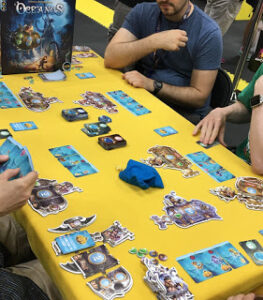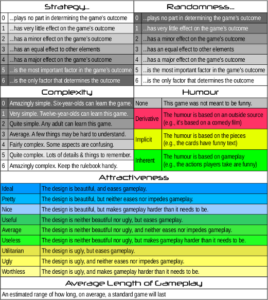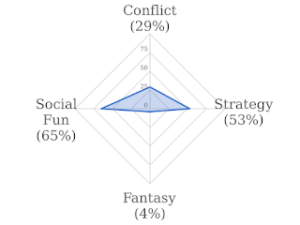 One of the great things about attending Gen Con was getting to play new releases, or preview games that were about to be released. Oceanos is one of those games. It’s a new release from Iello, the company that publishes the King of Tokyo line. In this game, players control whimsical submarines exploring the depths of the ocean to collect animals for their aquariums. You also gain points for other items, such as treasure chests and coral reefs.
One of the great things about attending Gen Con was getting to play new releases, or preview games that were about to be released. Oceanos is one of those games. It’s a new release from Iello, the company that publishes the King of Tokyo line. In this game, players control whimsical submarines exploring the depths of the ocean to collect animals for their aquariums. You also gain points for other items, such as treasure chests and coral reefs.
But I’m getting ahead of myself. Let’s start at the beginning, by looking at the numbers for Oceanos.

Strategy: 3
Randomness: 3
Complexity: 3
Humour: None
Attractiveness: Pretty
Average Length of Game Play: 45 minutes
In addition, I recently discovered a really neat tool. It’s the Quantic Foundry Board Game Motivation Profile. It determines what sort of board games you’re likely to enjoy by measuring you on four different scales: Conflict, Strategy, Fantasy, and Social Fun. Here’s my profile, in case you’re curious:
 Conflict measures how much you like games that involve taking direct hostile action against other players. This can be destroying buildings or units, forcing discards, or stealing resources. Strategy measures how much you like cognitive challenges. In other words, how ‘thinky-thinky’ do you like your games? Fantasy describes how much you like your games to be immersive. That is, do you want a game to make you feel as if you’re in another world, another time? Finally, Social Fun measures whether games are a social tool for you. To put it another way, do you play games to win? Or do you play games because you like to sit around with friends?
Conflict measures how much you like games that involve taking direct hostile action against other players. This can be destroying buildings or units, forcing discards, or stealing resources. Strategy measures how much you like cognitive challenges. In other words, how ‘thinky-thinky’ do you like your games? Fantasy describes how much you like your games to be immersive. That is, do you want a game to make you feel as if you’re in another world, another time? Finally, Social Fun measures whether games are a social tool for you. To put it another way, do you play games to win? Or do you play games because you like to sit around with friends?
I like this tool so much that I’m going to start rating games on the first three categories in addition to my other rankings. Social Fun isn’t really applicable, as that’s more about the players than the game itself. So for Oceanos, here are the new rankings:
Strategy: Medium
Conflict: Low
Fantasy: Medium
An Overview of Oceanos
Players start the game with a cute little cartoon submarine. These submarines are modular, so you can switch out parts as the game goes on. Each submarine consists of five pieces: the cockpit, the propeller, the motor, the aquarium, and the airlock. Each piece is upgradable. To upgrade a component, you replace the existing piece with the larger one. More on this in a moment.
The object of Oceanos is to travel through the sea collecting items, each of which is worth points. To do this, you play cards from your hand to represent the items you encounter as you travel. These cards can have a number of different icons on them, including various sea creatures, treasure chests, coral reef segments, crystals, underwater base icons, and the kraken icon. You can gain (or lose) points for each of these items in various ways.
Your Submarine
The submarines in Oceanos are cute little cartoony pseudo-steampunk contraptions. The cockpit has a representation of your character(s). As you collect crystal icons, you can purchase upgrades to the other parts of your submarine. You start with all five pieces at level 1, and can upgrade each piece, up to level 3.
-
- Cockpit: when dealing cards at the beginning of each round, you get one card plus the level of your cockpit (so you get 2 cards at the beginning, 3 cards once you upgrade the cockpit to level 2, and 4 cards if you upgrade to level 3).
- Airlock: you have a number of divers equal to the level of your airlock. Divers are useful because they can collect treasure chests. Thus, the more divers you have, the more points you can get from treasure chests.
- Aquarium: this piece determines how many sea creatures you can collect. Level 1 aquariums let you collect up to 3 creatures each round. A Level 2 segment allows you to collect up to 5. Level 3 lets you collect up to 8.
- Motor: The motor holds a number of fuel tokens equal to its level. You can spend a fuel token to play two cards at once.
- Propeller: Level 1 propellers do nothing. Level 2 propellers give you two bonus points at the end of each round. Level 3 propellers give you 5 bonus points.
The Sea Card Icons
Oceanos takes place over three rounds. In each round, cards are played from left to right to form a row. When playing round 2, the row goes directly below the cards you played in round 1. The round 3 cards go below that, so that at the end of the game, you’ll have a grid of three rows of cards.
The icons in Oceanos are:
- Sea Creatures: These are cute cartoony animals, like an octopus wearing goggles or a hammerhead with a top hat and cane. Each unique creature in a round is worth 2 points. Thus, if you play two pirate crab cards in the same round, you only get points for one of them. Also, remember the limit of the level of your submarine’s aquarium.
- Treasure Chests: You may deploy a diver onto a card as you play it. You collect one treasure token for each treasure chest on the current card plus all the cards directly above it.
- Coral Reef Segments: At the end of the game, players score one point for each coral reef segment in their largest connected chain.
- Power Crystals: Power crystals are used to activate the underwater base icons (see below). They come in either green or yellow varieties.
- Underwater Base: When you play an underwater base, it is activated by any unused crystals to the left in that row. A single crystal lets you upgrade a level 1 submarine segment to a level 2 segment. If there are both a green and a yellow power crystal available, then you can upgrade a level 2 segment to a level 3.
- Kraken: At the end of each round, the player with the most kraken icons in the current row takes the kraken token for the current round. These are usually worth negative points.
General Oceanos Game Play
In each round, the player with the Captain token deals the appropriate number of cards to each other player (not to himself). Players choose one card to play (unless they choose to spend a fuel token to play two cards) and give the rest to the Captain. The captain chooses from these cards. Players reveal their cards simultaneously, and deploy divers if they so desire. Then the captain token passes to the left, and the new Captain deals for the next turn.
At the end of each round, players cap the row with the round end tile, which counts as an underwater base token, so any unused power crystals can be used. They score the unique sea creatures, plus points for upgraded propellers if applicable, and award the kraken token. Fuel tokens are reset, and then you move on to the next round.
At the end of round three, in addition to the above, players score their coral reefs. They also reveal their treasure tokens, scoring points for them as well. The player with the most points is the winner.
Final Thoughts on Oceanos
This is a really neat little game. The artwork is fun, game play is different from anything I’ve encountered before, and the premise is pretty cool. It’s definitely not a deep or serious game; I’d almost say it’s more of a family game, but some of the mechanics can be really hard for younger players. My only complaint about Oceanos is that with the modular submarines, there are a lot of pieces, which means the game can take up a lot of room. Still, I don’t have a better idea how to handle that particular mechanic, so I’m not going to complain too much about it. It is a pretty nifty part of the game though.
Anyway, next week, I think I’m going to write about the diversity panel that I attended. I still have five more article ideas after that, so don’t despair. There will be more Gen Con articles for a little while yet! In the meantime, play more games, and remember to always
